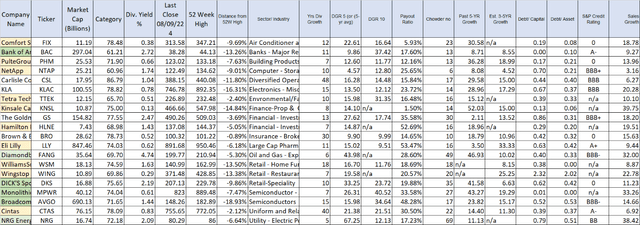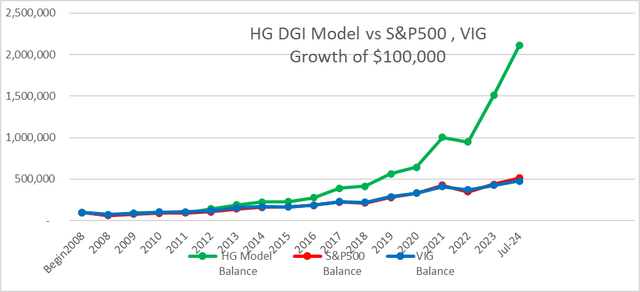Our Top 10 Dividend Growth Stocks – August 2024

Olivier Le Moal
In this series of articles, we focus on selecting and highlighting stocks that have rapidly grown their dividends in the recent past. We also need to ensure that these stocks will likely grow their earnings at a fast pace in the upcoming years. Due to their hypergrowth, their price generally grows quickly, and they usually do not pay very high current yields. With high-growth stocks, we need to be content with a lower current yield. However, please keep in mind that nothing is permanent, and with time, their business model matures, or new competition/technology can emerge and change their growth patterns. That’s why it may be important that we monitor these stocks at least every quarter.
If you need higher yields, please read the most recent article from our monthly series titled “5 Relatively Secure and Cheap DGI,” which focuses on moderate to high current income — favoring high-yield names. Irrespective of whether your goal is high dividend growth or high current income, we always need to pay attention to the quality of companies that we invest in and the price we pay.
Note: Please note that the stocks shortlisted and highlighted in this article are not buy recommendations per se but rather candidates for further research. Before making any investments, please use your due diligence, considering your personal goals and risk tolerance. Also, some sections in the article (Introduction, Selection methodology/process, etc.) will be repetitive from month to month for the benefit of the new readers. Such sections would be displayed in “italics,” and regular readers could skip them.
Why High-Growth Dividend Stocks?
There are two types of dividend stocks that a DGI investor can choose from depending upon their individual situation, goals, and investing time horizon:
High Growth Low Yield [HGLY]
Low Growth High Yield [LGHY].
As the names suggest, the HGLY category would have stocks that offer a high rate of dividend growth but usually a low current yield. These stocks would normally have low payment ratios, manageable levels of debt, and rapidly rising earnings.
On the other hand, LGHY-type stocks would offer a high current yield (generally 3% and higher) but a lower rate of dividend growth. Generally speaking, these companies are more mature and stable businesses that have their hyper-growth period in the rearview but still grow modestly over time to support a low but stable growth in dividends.
Obviously, there will be stocks that fit somewhere in between these two categories, for example, medium growth and medium current yield.
So, who should own HGLY-type stocks? Basically, anyone who is in the accumulation phase and does not need the income currently and/or in the next five to ten years should own some high-growth dividend stocks. In addition, folks (including retirees) with large investment capital that generates more income than they require (for example, 1.5x or 2x their income needs) should invest in HGLY-type stocks, at least partially.
How To Structure A Portfolio Based On This Series
Though it would depend a great deal on your personal goals, risk tolerance, investment methodology, and choices if you wish to make a portfolio based on this monthly series, here is one way to do it
- Make a portfolio budget and provision to have a maximum of 20 stocks over time.
- Divide your capital (current + future) into 20 equal parts.
- In the first month, buy 5 to 6 positions based on the 10 top stocks for that month.
- From the next month onwards, check for the new stocks appearing in the top 10 list that are not part of your portfolio, and add new positions (possibly no more than two a month or as many as your process and budget allow).
- Repeat step 4 until you reach 20 (or max) positions.
When you have reached the maximum 20 positions and have no more capital to add, look for new stocks in our monthly report or based on your own research. If you decide to add a position, you need to find a position you would like to drop and replace it with a new one.
It may also be recommended to monitor your positions periodically, preferably monthly, but at least quarterly. Also, make sure that you do not overweight any particular sector or industry segment.
Selection Criteria
We will draw upon our original current month’s data set, taken from our other DGI series (5 Relatively Safe and Cheap DGI), and update it with the current data. We will then apply additional criteria to filter out stocks that have provided a high rate of dividend growth in the recent past and are likely to continue on that path for the foreseeable future.
Please see our original article to get a complete spreadsheet of this dataset. For the sake of clarity, we will list the original filtering criteria below:
- Market cap > $10 billion (some exceptions can be made)
- Dividend yield > 1.0% (some exceptions are made to include high quality but lower yielding companies)
- Daily average volume > 100,000
- Dividend growth past five years >= 0 (we will check for high growth later).
- Preferably, a minimum of 5 years of positive dividend growth.
Subsequent to the above filter, we calculated a score (Dividend Safety Quality Score) that was derived based on the following factors:
- Current Yield
- Dividend growth history (number of years of dividend growth):
- Payout ratio — Preferably based on Free Cash Flow.
- Past five-year and 10-year dividend growth
- EPS growth (average of previous five years of growth and expected next 3–5 years’ growth)
- Chowder number — the sum of the 5-yr dividend growth rate and the current yield
- Debt/equity and Debt/asset ratios
- S&P’s credit ratings (Standard & Poor’s Global Ratings)
- Distance from 52-week high (current price minus 52-wk high price)
- Sales or Revenue growth for the past five years.
Notes: All tables in this article are created by the author unless explicitly specified. The stock data have been sourced from various sources such as Seeking Alpha, Yahoo Finance, GuruFocus, IBD, and CCC-List (dripinvesting).
Additional Criteria for Dividend Growth Stocks
A vast majority of stocks selected so far have raised their dividend payouts for five years or more. However, some may not have raised consistently but have paid dividends for a long duration and raised them only periodically. However, as an additional criterion, now we will filter out stocks that have increased their dividend payouts (average of 5-year and 10-year) by an average annual rate of 8% or more (some exceptions are made if the Chowder number is decent). We will also consider stocks that may not have provided a consistent yearly increase but have provided a cumulative increase of 30% in payouts in the past five years.
We will now use the following additional criteria to filter out stocks that would fit the mold of high-growth DGI stocks.
- The payment Ratio (on a cash-flow basis or EPS basis) is less than 80%.
- 5-year Dividend growth is at least 7.5% or greater. This is in line with the growth rate of the benchmark fund, Vanguard Dividend Appreciation Index Fund ETF Shares (VIG). However, if the 5-year growth rate is less than 7.5%, but the 10-year dividend growth rate exceeds 7.5%, we will keep it.
- Chowder number (5-YR dividend growth plus the dividend yield) >= 9. The Chowder number is the sum of the current yield and the dividend growth rate of the last five years. However, if the 5-YR dividend growth rate is less than 7.5%, we will check if the 10-YR growth rate is 7.5% or higher.
After we apply these criteria, we are left with close to 300 stocks on our list. Until this stage of filtering, we kept the base criteria loose enough to allow a wide variety of stocks to make the list. However, we will perform additional filtering in the next stage to get the best candidates.
Most growth investors appreciate how important the earnings growth (earnings per share — EPS) is for a stock to grow its dividend rapidly. Without growth in earnings, the company cannot grow its dividends for long. Sure, some companies may try to do it by taking on more debt, cutting costs, or spending less on R&D and capital, but such measures cannot be sustained long before they start causing wider issues. So, our focus ought to be on earnings growth.
In our spreadsheet, we will add four more columns of data for each of the stocks:
- EPS (earnings per share) Rating
- Last Qtr EPS change % (actual)
- Current Qtr EPS change % (est.)
- Current year EPS change % (est.).
We will now assign weights to these four sets of data for each stock and add them to the original “Dividend Safety Quality Score” to come up with a modified Quality Score tilted in favor of high dividend growth stocks. We will call this column a High-Growth Quality-Score [HGQS].
Narrowing Down the List To 20 Stocks
From the above list of roughly 300 stocks, we will select roughly 45 stocks based on the following methodology.
- Top 15 stocks based on the highest HG-Quality-Score (adjusted for sector or industry over concentration).
- Top 10 stocks based on the highest 5-year dividend growth.
- Top 10 stocks based on the highest 10-year dividend growth.
- Top 10 stocks based on average of EPS Rating (earnings per share) and RS rating (Relative Strength). (EPS and RS ratings are taken from IBD; subscription is required).
Table-1A: Top 15 Highest HG-Quality-Score Stocks:
Table-1B: Top 10 Highest Past Dividend Growth Stocks (5 years):
Table-1C: Top 10 Highest Past Dividend Growth Stocks (10 years):
Table-1D: Top 10 Stocks with Highest EPS and RS Rating:
We will now remove the duplicates from this list, as many stocks qualify based on multiple criteria.
Appeared twice: CI, CTAS, FIX, GFI, MS, and TTEK (6 duplicates).
We are now left with 39 (45–6) names.
We will also remove any names where the revenue growth (over the past five years) has been negative. There is none on the list.
We will now calculate the average of EPS and RS (relative strength) ratings and remove any names that have an average of less than 60. This removes GFI, TGT, CDW, MOS, and TSCDY (leaving us 34 names).
We will also remove any names that have both the EPS and RS less than 85. There are none meeting this condition.
Next, we will remove any stock that has an RS rating of less than 50. This removes LRCX, CI, V, and ODFL, leaving us with 30 names.
Finally, we will remove some stocks to avoid over-concentration from one sector or industry segment. We prioritize the stocks that have higher Relative Strength and EPS ratings.
Computer Technology: We have four names from different segments, but there are still too many. So, we keep NTAP but remove LOGI, MSFT, and QCOM (due to low relative strength).
Tech-Semi’s: We keep AVGO and MPWR and remove OLED.
Finance-Prop & Casualty Ins: We keep KNSL but remove TRV.
Finance-Investment Banking: We keep GS but remove MS.
Home-Building: We keep PHM but remove LEN and DHI.
We also remove OC and AMH (due to poor Relative Strength).
In all, we removed ten names, so we are finally left with 20 (30-10) names, which are presented in the table below:
(FIX), (BAC), (PHM), (NTAP), (CSL), (KLAC), (TTEK), (KNSL), (GS), (HLNE), (BRO), (LLY), (FANG), (WSM), (WING), (DKS), (MPWR), (AVGO), (CTAS), and (NRG).
Table 2: Top 20 High Growth DGI Stocks of the Month:
Final Step: Selection of Top 10 High Growth DGI Stocks
This final step of bringing down the number of selections to just ten stocks is a subjective process. We try to keep the group as diverse as possible, representing many sectors and industry segments. We encourage readers to look at the wider selection of 20 stocks and see if they come up with anything different and appropriate for their goals. Nonetheless, we describe below how we go about selecting these ten stocks for the month.
To start with, we will sort out our list of the above 20 stocks based on sector-industry segment and then in descending order of net quality score.
We try to select one stock from each industry segment from top to bottom; however, at times, multiple stocks could appear from the same sector. We will select either the top (or the second one) from each industry segment. While making this final selection, we also looked at the EPS rating and the momentum (Relative strength).
In this list, we do not give much weightage to how a stock is priced currently (in terms of valuation) or the current yield, since many of these high-growth stocks may not trade at cheap valuations.
Here are our top 10 selections for this month.
Current Month Selections (August 2024):
(FIX), (BAC), (PHM), (NTAP), (CSL), (LLY), (DKS), (AVGO), (CTAS), and (NRG).
Previous Month Selections:
(FIX), (BAC), (MSFT), (NTAP), (QCOM), (CSL), (LLY), (DKS), (AVGO), and (NRG).
Since our methodology is based largely on a filtering process, we would like to point out that once a stock has appeared on our list, it may repeat for at least a few months. On average, we see about 30% to 40% turnover from one month to another month, but it can really vary. We do not change stocks just for the sake of changing.
Note: Please note that if a stock was in a previous month’s list but is no longer selected in the current list, it does not mean the stock is no longer a good choice. If the stock still scores an HG-Quality score of >70, we think it could still be at least a “hold” (if not a “buy”). However, for new selections, we take into account many more factors than just the HG-Quality score. The purpose here is to highlight the top candidates every month. Please conduct further research and due diligence before making buy or sell decisions.
Table 3: (High Growth DGI)
Past Performance
Now, let’s take a minute and see how our model portfolio of these ten high-growth stocks would have performed until the last month since the beginning of 2008 compared to the benchmark Vanguard Dividend Appreciation Index Fund ETF or the S&P 500 (SP500). The assumption is that our model portfolio was invested equally in ten stocks and rebalanced every year. Please remember that this is a back-tested performance, not an actual one. It is almost certain that we would not have picked the same set 17 years ago. So, this is more of an academic exercise. Also, past performance is no guarantee of any kind for future returns.
Chart-1:
Note: The stock AVGO did not have a history before 2010, so it was not used for those two years.
Performance Since Jan. 2023:
We compare the performance of the portfolio with the benchmark fund, Vanguard Dividend Appreciation ETF, and the S&P 500. We report the cumulative figures since Jan. 2023 just to provide a broad comparison. Obviously, the performance will vary from month to month. Furthermore, the performance of benchmarks may not match with a buy-and-hold portfolio, as we take the performance from a specific start date and end date every month to match our 10-HG portfolio.
Table-3A:
Concluding Remarks
In this monthly article, our primary focus is on selecting high-growth dividend stocks, not just any dividend stock. Usually, such stocks are in their hyper-growth period, and their valuation is generally rich. This is also why their dividend yields are at the low end. This month, again, most of these stocks are trading near their 52-week highs as the market, in general, is near its all-time peak. If the market were to fall from here, these stocks may decline even more. So, this list may not be appropriate for conservative investors but rather for a more selective growth-oriented audience.
Based on our rule-based filtering process, we start with numerous stocks every month and narrow down the list to under 20 names. As a final step, we use subjective analysis and our judgment to select ten stocks that form a diversified group and will likely offer high growth at reasonable values.














